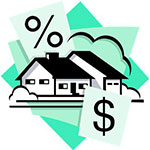
Interest rates are boring but can be very revealing. At Columbia Business School, I learned macroeconomics from a professor who went on to become a member of the Board of Governors at the Federal Reserve. He taught us easy ways to find interesting clues in the levels of interest rates. One metric we learned to find levels of interest rates was to measure risk premiums by comparing the interest rates on the 10 year T-Notes to the average 10 year yield on junk bonds. T-bills are the highest credit quality and junk bonds the lowest (excluding deadbeat countries like Argentina). When you subtract the two rates, it gives you the premium that investors require to hold something risky, in this case a junk bond. The historical average between the two rates is about 500 basis points. When this spread narrows too much, it means that investors feel less risk or that investors are underpricing risk relative to reality. Risk is never perfectly priced so either something is priced too high or too low.
This was absolutely the case right before the market crash in 2008. In June 2007, at the peak of the last credit cycle, the spread between the two rates narrowed to an all-time low of 240 basis points. So this spread was 50% less than the normal historical spread. During the worst of the financial crisis, the spread zoomed in the other direction and was almost two thousand basis points. So for the same asset class, investors went from requiring a spread of 240 basis points to a spread of two thousand basis points – nearly eight times! Quite a correction!. Last month, the spread was down to 321 basis points. Almost 40% lower than average. Historically, this is a very bad omen because when investors are underpricing risk, there is too much speculation in the market which means assets are overpriced. When things begin to correct, and investors realize they were underpricing risk, they head for the exits driving the risk premium back up. So while I am not a member of the Federal Reserve or an expert in economics, I would say that this environment has a familiar feel to it. Junk bond rates, as a proxy for the wider financial market, appear to be flashing a warning signal.
